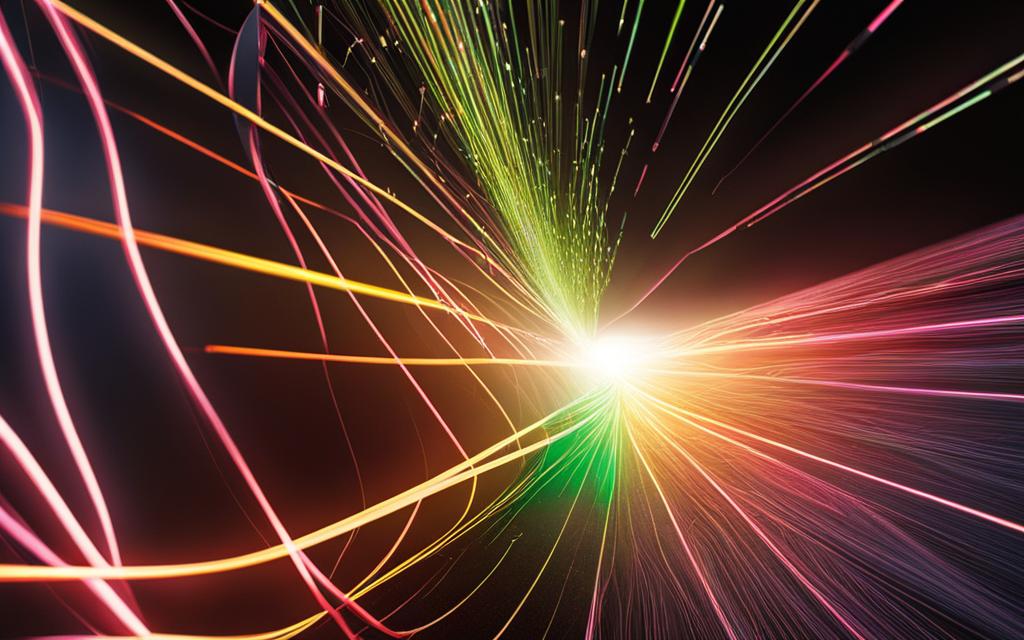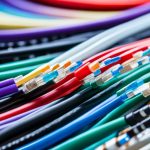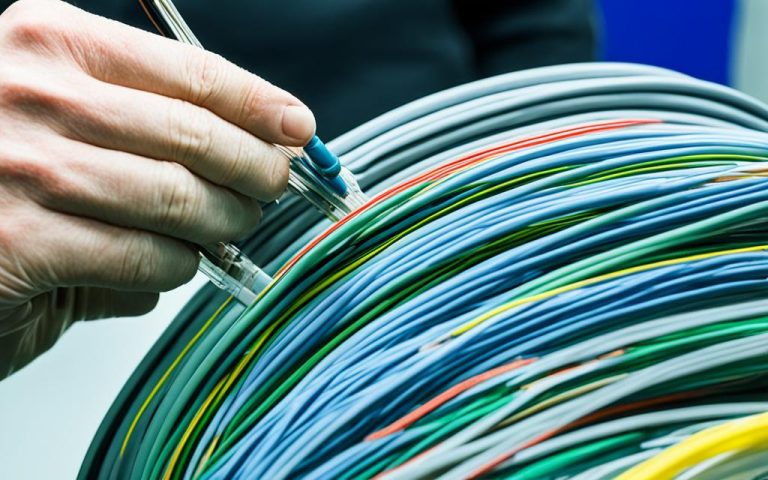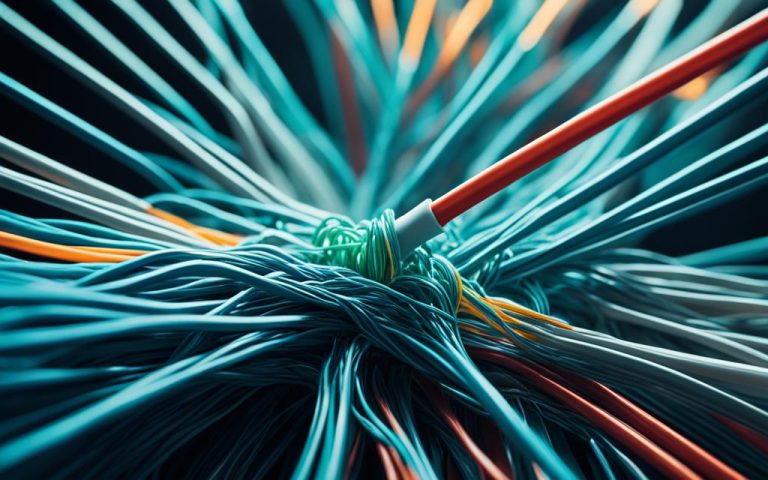Welcome to our comprehensive guide on fiber optics. In this article, we will delve into the basics of fiber optics, from understanding the theory behind it to its real-world applications. Fiber optics technology has transformed the way we communicate and is widely used in various industries.
Fiber optic theory forms the foundation for this innovative technology. By gaining insights into how light is transmitted through optical fibers, you will develop a deeper understanding of its functionality. We will explore the properties of light in fiber optics, including reflection, refraction, diffusion, and absorption.
Real-world applications of fiber optics are vast and varied. From telecommunications networks to sensing and power delivery systems, fiber optics has revolutionized how we transfer data and communicate. We will delve into the advantages and disadvantages of fiber optics, providing you with a comprehensive overview of this technology.
By the end of this article, you will have a solid grasp of the fundamental principles of fiber optics and be better equipped to understand its practical applications. Let’s embark on a journey to explore the fascinating world of fiber optics.
The History of Fiber Optics
Fiber optics has a rich history that spans several decades. Its development can be traced back to the early 19th century when the concept of total internal reflection was first discovered. This breakthrough paved the way for the advancements in fiber optic technology that we see today.
However, it wasn’t until the 1960s that the first practical fiber optic systems were developed. These systems were initially used in medical imaging and endoscopy. Their potential for telecommunications was realized soon after, leading to further research and innovation in this field.
Fiber optic technology quickly gained traction due to its numerous advantages over traditional copper wiring. It offered faster data transmission speeds, higher bandwidth, and immunity to electromagnetic interference. These qualities made fiber optics an ideal choice for long-distance communication.
“Fiber optics is a game-changer in the world of communications. It has revolutionized the way we transmit data, enabling faster and more reliable connections.” – Fiber Optics Expert
Over the years, fiber optics has continued to evolve and improve. The development of new materials and manufacturing techniques has made it more efficient and cost-effective. Today, fiber optic cables are widely used in telecommunications networks around the world, serving as the backbone of our digital infrastructure.
The development of fiber optics has transformed the way we communicate, enabling seamless global connectivity and driving innovation in various industries. From high-speed internet connections to telemedicine and beyond, fiber optics has revolutionized how we access information and interact with the world.
Key Milestones in the History of Fiber Optics
| Date | Event |
|---|---|
| 1800s | Discovery of total internal reflection |
| 1880s | Early experiments with light transmission through glass rods |
| 1920s | First patent for fiber optic technology filed by Narinder Singh Kapany |
| 1960s | Development of the first practical fiber optic systems |
| 1970s | Introduction of low-loss fibers and single-mode fibers |
| 1980s | Commercialization of fiber optic technology for telecommunications |
| 1990s | Advancements in wavelength division multiplexing (WDM) |
| Present | Ongoing research and development for higher data transmission speeds |
Advantages and Disadvantages of Fiber Optics
Fiber optics is a cutting-edge technology that offers numerous advantages over traditional copper wiring. Its ability to transmit data at high speeds with minimal loss makes it ideal for a wide range of applications. However, like any technology, fiber optics also has its downsides. In this section, we will explore the advantages and disadvantages of fiber optics, weighing the pros and cons of this innovative technology.
Advantages of Fiber Optics
Fiber optics provides a host of advantages that make it an attractive choice for various industries. Here are some key advantages:
- High Bandwidth: Fiber optics offers a significantly higher bandwidth compared to copper cables. This enables faster data transmission and supports bandwidth-intensive applications such as video streaming and cloud computing.
- Reliability: Fiber optic cables are less susceptible to signal interference and can withstand harsh environmental conditions. This results in more reliable data transmission and minimal downtime.
- Long Distance Transmission: Unlike copper wiring, fiber optics can transmit signals over longer distances without experiencing signal degradation. This makes it ideal for long-distance communication, such as connecting different geographical locations.
- Security: Fiber optic signals are difficult to tap into, making them more secure than traditional copper cables. This added security is crucial for industries that deal with sensitive and confidential data.
- Immunity to Electromagnetic Interference: Fiber optics is immune to electromagnetic interference, such as radio frequency interference and electromagnetic radiation. This ensures a clear and uninterrupted data transmission.
Disadvantages of Fiber Optics
While fiber optics has its advantages, it also has a few drawbacks that need to be considered:
- Cost: Fiber optic cables are more expensive to install compared to copper cables. The specialized equipment required for installation and maintenance also adds to the overall cost.
- Complex Installation: Installing fiber optic cables requires advanced technical knowledge and specialized equipment. This can make the installation process more complex and time-consuming.
- Fragility: Fiber optic cables are delicate and can be easily damaged if not handled with care. This makes them vulnerable to physical stress and environmental factors.
- Limited Availability: Fiber optic infrastructure may not be readily available in all areas, especially in remote or rural locations. This can limit the feasibility of implementing fiber optic networks.
“Fiber optics offers faster data transmission, reliable performance, and enhanced security, making it an attractive choice for industries across the globe.”
Despite these disadvantages, the benefits of fiber optics far outweigh the drawbacks, making it a preferred choice for high-speed data transmission and reliable communication systems.

Comparison of Advantages and Disadvantages of Fiber Optics
| Advantages | Disadvantages | |
|---|---|---|
| High Bandwidth | Allows faster data transmission | |
| Reliability | Resistant to signal interference and harsh conditions | |
| Long Distance Transmission | Signals can be transmitted over longer distances without degradation | |
| Security | Difficult to tap into, ensuring data security | |
| Immunity to Electromagnetic Interference | Unaffected by electromagnetic interference | |
| Cost | More expensive to install and maintain | |
| Complex Installation | Requires advanced technical knowledge and specialized equipment | |
| Fragility | Easily damaged if mishandled | |
| Limited Availability | May not be readily available in all areas |
Basic Principles of Light Transmission through Fiber Optics
The transmission of light through fiber optics is a fascinating process that relies on the principles of optics and electromagnetic theory. Understanding the basic properties of light and how it behaves within optical fibers is essential to grasp the inner workings of this technology.
Light, as we perceive it, is an electromagnetic wave consisting of oscillating electric and magnetic fields. The electromagnetic theory of light explains how these fields interact with matter and propagate through different mediums. When light enters an optical fiber, it undergoes several processes, including reflection, refraction, diffusion, and absorption.
Reflection occurs when light encounters a surface and bounces back, obeying the law of reflection. In the case of optical fibers, the inner walls are coated with a highly reflective material, allowing light to bounce along the length of the fiber. This total internal reflection is crucial for the efficient transmission of light through the fiber.
Refraction, on the other hand, takes place when light passes through a boundary between different mediums, causing it to change direction. In fiber optics, refraction occurs at the core-cladding interface, where the refractive index of the two materials differs. This phenomenon ensures that light remains trapped within the core and continues to propagate along the fiber.
Diffusion refers to the scattering of light as it encounters imperfections or irregularities within the fiber. These imperfections can cause light to deviate from its original path, leading to signal loss or degradation. Therefore, minimizing diffusion is crucial to maintain the integrity of transmitted data.
Lastly, absorption occurs when the fiber material absorbs some portion of the light, converting it into heat. Different materials have varying absorption characteristics, with some being more suitable for specific applications than others. Understanding the absorption properties of the fiber is vital in optimizing its performance.
An optical fiber is composed of a core, which contains the transmitted light, and a cladding that surrounds the core, providing a lower refractive index to facilitate total internal reflection. The material properties of these components, such as refractive index, attenuation, and dispersion, directly influence the transmission of light through the fiber.
By comprehending the basic principles of light transmission in fiber optics, we gain valuable insight into how this technology enables fast and reliable data communication. Let’s explore these concepts further and unlock the potential of fiber optics.
Components and Structure of Fiber Optic Systems
Fiber optic systems are complex networks that rely on various components to ensure the efficient transmission and reception of data. Understanding the structure and function of these components is crucial for the design and implementation of fiber optic networks. In this section, we will explore the key elements involved in fiber optic systems and discuss the principles of fiber optic network design.
Fiber Optic Components
Central to any fiber optic system are the optical cables, connectors, and enclosures that make up its physical infrastructure. Let’s take a closer look at each of these components:
Optical Cables:
Fiber optic cables are designed to transmit light signals over long distances. They consist of one or more optical fibers, each made of thin strands of high-quality glass or plastic. These fibers are protected by layers of insulation and a protective jacket to prevent damage from environmental factors.
Connectors:
Fiber optic connectors are used to join optical fibers together, allowing for the seamless transmission of light signals. These connectors ensure a precise and reliable connection between fibers, minimizing signal loss and maintaining signal integrity. Common types of fiber optic connectors include SC, LC, and ST connectors.
Enclosures:
Fiber optic enclosures provide protection and organization for the optical cables and connectors. They are typically designed with a rugged and durable construction to withstand harsh environments. Enclosures also ensure proper cable management and facilitate easy access for maintenance and upgrades.
Structure of Fiber Optic Systems
The structure of a fiber optic system can vary depending on its application and scale. However, most fiber optic systems follow a similar basic structure:
- Transmitter: The transmitter converts electrical signals into optical signals that can be transmitted through the optical fibers.
- Optical Fiber: The optical fiber serves as the medium for transmitting light signals over long distances.
- Receiver: The receiver receives the optical signals and converts them back into electrical signals for further processing.
These three components are interconnected through the fiber optic cables and connectors, forming a closed loop that allows for bidirectional communication.
Fiber Optic Network Design
The design of a fiber optic network involves careful planning and consideration of various factors, including:
- Transmission Distance: The distance over which the optical signals need to be transmitted will dictate the specifications of the optical cables and the power requirements of the transmitter and receiver.
- Bandwidth Requirements: The intended data transfer rates and the number of users or devices connected to the network will determine the required bandwidth capacity.
- Interference and Reliability: Minimizing interference from external sources, such as electromagnetic radiation, and ensuring robustness and reliability are critical aspects to consider in the design of a fiber optic network.
By carefully considering these factors and selecting the appropriate components, a well-designed fiber optic network can provide reliable and high-speed communication capabilities.
| Component | Description |
|---|---|
| Optical Cables | Transmit light signals over long distances |
| Connectors | Join optical fibers together |
| Enclosures | Provide protection and organization for cables and connectors |
Conclusion
In conclusion, fiber optics is a fundamental technology that plays a crucial role in modern communications. By gaining a comprehensive understanding of the basic principles of fiber optics, including its history, advantages, and disadvantages, individuals working in the field of telecommunications can make informed decisions and drive innovation.
Exploring the theory of light transmission through fiber optics and comprehending the components and structure of fiber optic systems is essential for designing, overseeing, and maintaining efficient and reliable fiber optic networks. This knowledge empowers professionals to optimize network performance and ensure seamless connectivity.
Moreover, fiber optics finds applications in various industries beyond telecommunications. The technology’s high bandwidth and immunity to electromagnetic interference make it valuable in sectors such as sensing and power delivery. Understanding the fundamentals of fiber optics opens up a world of possibilities, enabling individuals to explore and harness the full potential of this versatile technology.
FAQ
What is fiber optics?
Fiber optics is a technology that uses thin strands of glass or plastic to transmit data in the form of light pulses. It offers faster and more reliable data transmission compared to traditional copper wiring.
What are the advantages of fiber optics?
Fiber optics has several advantages, including higher bandwidth for faster data transmission, immunity to electromagnetic interference, and the ability to transmit signals over longer distances without degradation in quality.
What are the disadvantages of fiber optics?
The main disadvantages of fiber optics are the higher installation costs and the need for specialized equipment for installation and maintenance.
How does light transmission through fiber optics work?
Light transmission through fiber optics is based on the principles of optics and electromagnetic theory. It involves the reflection, refraction, diffusion, and absorption of light within the optical fibers.
What are the components of a fiber optic system?
A fiber optic system consists of optical cables, connectors, and enclosures. These components work together to transmit and receive data.





















4 Comments